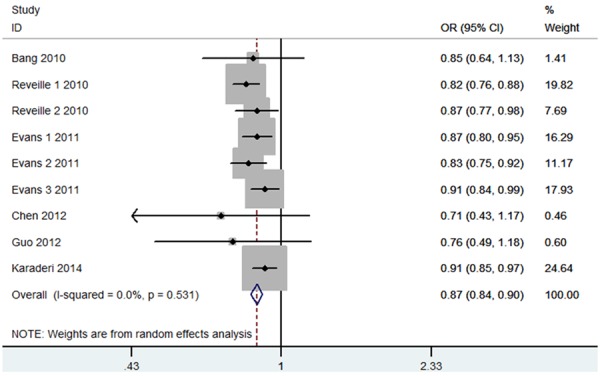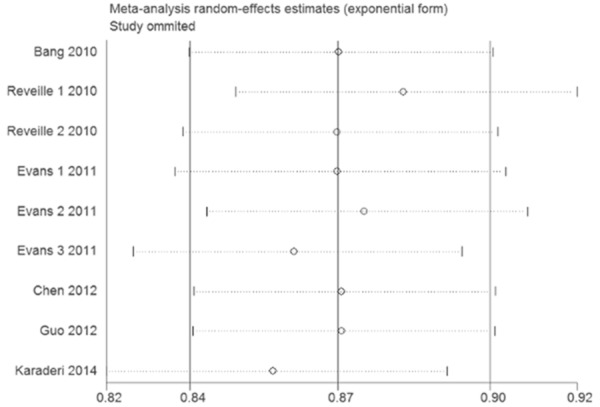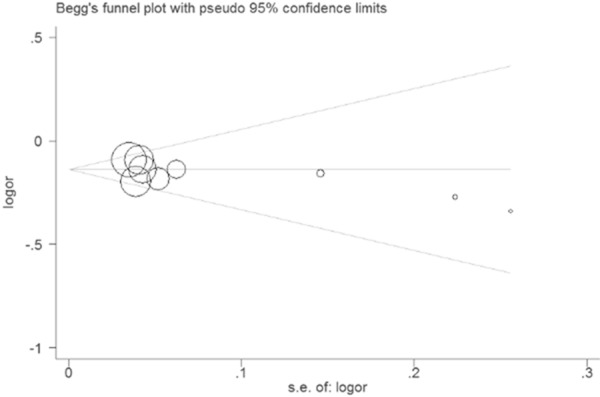Abstract
Results of recent published studies on the association between the ANTXR2 rs4333130 polymorphism and the risk of ankylosing spondylitis (AS) have often been conflicting. To make a more precise estimation of the potential relationship, a meta-analysis was performed. We conducted a comprehensive search in the electronic database of PubMed and Embase to retrieve relevant articles. Nine studies including 14,523 cases and 34,421 controls were finally selected in this meta-analysis. ANTXR2 rs4333130 was significantly associated with a decreased risk of AS (OR=0.87; 95% CI, 0.84-0.90; P<0.00001). In the subgroup analysis by race, ANTXR2 rs4333130 was significantly associated with a decreased risk of AS in both Asian (OR=0.80; 95% CI, 0.65-0.99; P=0.04) and Caucasian (OR=0.87; 95% CI, 0.84-0.90; P<0.00001). In the subgroup analysis by HLA-B27 status, HLA-B27 positive individuals with ANTXR2 rs4333130 showed decreased AS risk (OR=0.89; 95% CI, 0.83-0.96; P=0.002). However, HLA-B27 negative individuals with this polymorphism did not showed decreased AS risk (OR=0.96; 95% CI, 0.88-1.06; P=0.44). In conclusion, this meta-analysis suggested a significant association between ANTXR2 rs4333130 polymorphism and AS risk.
Keywords: Ankylosing spondylitis, ANTXR2, meta-analysis, genetic
Introduction
Ankylosing spondylitis (AS) is a chronic inflammatory disorder that mainly affects the sacroiliac joints and lumbar spine. New bone formation is one of the hallmark characteristics of the disease, which is thereby associated with syndesmophytes and ankylosis [1]. Between 1% and 3% of the population may be affected by AS [2]. All of this leads to a substantial socio-economic burden in terms of both labour costs, due to the higher incidence of these diseases in the 20- to 60-year-old age range, and health care expenditure and social dependence, particularly in elderly patients [3].
Human leucocyte antigen (HLA)-B27 was the first molecule found to be associated with AS, but HLA-B27 positivity accounts for only some of the overall risk for AS [4]. Recent studies identified that the polymorphisms in ANTXR2 rs4333130 was found to be strongly associated with AS. However, other studies did not confirm this result [5-11]. Thus, we did a meta-analysis to assess the association between this polymorphism and the risk of AS.
Methods
Publication search
We conducted a comprehensive search in the electronic database of PubMed and Embase to retrieve relevant articles. We retrieved the relevant articles using the following terms: “ankylosing spondylitis”, “ANTXR2”, and “polymorphism or variant or mutation” as well as their combinations. We searched the references of retrieved articles with no language restriction.
Inclusion and exclusion criteria
Studies were included if they met the following criteria: 1) evaluation of ANTXR2 rs4333130 and AS risk; 2) retrospective case-control studies or prospective cohort studies; 3) sufficient data to examine an odds ratio (OR) with 95% confidence interval (CI); 4) conforming to Hardy-Weinberg equilibrium (HWE) in the control group. Studies were excluded when: 1) not case-control studies; 2) case reports, letters, reviews, editorial articles, and animal studies; 3) duplicate or insufficient data; 4) family-based design; 5) controls were not in HWE.
Data extraction
Data from published studies were extracted carefully. For each study, we collected the following information: first author, year of publication, country, ethnicity, numbers of cases and controls, evidence of HWE and HLA-B27 status.
Statistical analysis
The overall effect was measured by ORs with its 95% CI. The significance of the pooled ORs was determined by the Z test with a P value less than 0.05 considering statistically significant. The perallele model was examined to assess this association. Between-studies heterogeneity was assessed by the I2 test and the Qstatistic test. The random-effect model was used. The publication bias was estimated by visual funnel plot inspection. To assess whether our results were substantially influenced by the presence of any individual study, we proceed a sensitivity analysis by removing each study and recalculating the significance of the result. Statistical analyses were conducted in STATA version 11.0 (Stata Corporation, College station, TX, USA). All the tests were two-sided.
Results
Study characteristics
According to the inclusion and exclusion criteria, a total of 6 publications were included in this meta-analysis [5-11]. We noticed that 2 studies reported two and three independent studies and each group was considered separately in pooling analyses. Therefore, 9 studies including 14,523 cases and 34,421 controls were finally selected in this meta-analysis. Characteristics in this meta-analysis are summarized in Table 1.
Table 1.
Characteristics of included studies
| Author | Year | Country | Ethnicity | Cases | Controls | HWE | HLA-B27 status |
|---|---|---|---|---|---|---|---|
| Bang | 2010 | Korea | Asian | 1164 | 752 | Yes | NA |
| Reveille 1 | 2010 | Mixed | Caucasian | 2053 | 5140 | Yes | NA |
| Reveille 2 | 2010 | Mixed | Caucasian | 898 | 1518 | Yes | NA |
| Evans 1 | 2011 | Mixed | Caucasian | 1787 | 4800 | Yes | Reported |
| Evans 2 | 2011 | Mixed | Caucasian | 3023 | 8779 | Yes | Reported |
| Evans 3 | 2011 | Mixed | Caucasian | 2111 | 4483 | Yes | Reported |
| Chen | 2012 | China | Asian | 200 | 200 | Yes | NA |
| Guo | 2012 | China | Asian | 309 | 384 | Yes | NA |
| Karaderi | 2014 | UK | Caucasian | 2978 | 8365 | Yes | Reported |
HWE, Hardy-Weinberg equilibrium.
Results of meta-analysis
Table 2 presents the results of meta-analysis and the heterogeneity test. ANTXR2 rs4333130 was significantly associated with a decreased risk of AS (OR=0.87; 95% CI, 0.84-0.90; P<0.00001; Figure 1). In the subgroup analysis by race, ANTXR2 rs4333130 was significantly associated with a decreased risk of AS in both Asian (OR=0.80; 95% CI, 0.65-0.99; P=0.04) and Caucasian (OR=0.87; 95% CI, 0.84-0.90; P<0.00001). In the subgroup analysis by HLA-B27 status, HLA-B27 positive individuals with ANTXR2 rs4333130 showed decreased AS risk (OR=0.89; 95% CI, 0.83-0.96; P=0.002). However, HLA-B27 negative individuals with this polymorphism did not showed decreased AS risk (OR=0.96; 95% CI, 0.88-1.06; P=0.44).
Table 2.
Summary of results from meta-analysis and subgroup analysis
| No. of studies | OR (95% CI) | P Value | P heterogeneity | |
|---|---|---|---|---|
| Overall | 9 | 0.87 (0.84-0.90) | <0.00001 | 0.53 |
| Asian | 3 | 0.80 (0.65-0.99) | 0.04 | 0.79 |
| Caucasian | 6 | 0.87 (0.84-0.90) | <0.00001 | 0.30 |
| HLA-B27 positive | 4 | 0.89 (0.83-0.96) | 0.002 | 0.91 |
| HLA-B27 negative | 4 | 0.96 (0.88-1.06) | 0.44 | 0.49 |
Figure 1.

Meta-analysis for the association between ANTXR2 rs4333130 and AS risk.
Sensitivity analyses were conducted to assess the influence of each individual study on the pooled OR by removing one study at a time. In the overall meta-analysis, no single study changed the pooled results, which indicates that the results were statistically stable and reliable (Figure 2).
Figure 2.

Sensitive analysis for the association between ANTXR2 rs4333130 and AS risk.
The shapes of the funnel plot appeared symmetrical (Figure 3). The p-value of the Egger’s test is 0.654, suggesting no evidence of publication bias.
Figure 3.

Funnel plot for the association between ANTXR2 rs4333130 and AS risk.
Discussion
AS is characterized by inflammation and des-truction of sacroiliac joint and stiffness of spine. It is widely confirmed that genetic factors play a substantive role in the pathogenesis of AS. Increasing evidence demonstrates that a substantial proportion of AS susceptibility is associated with nonmajor histocompatibility complex genes. Harvey et al. suggested that ERAP1 is a good candidate for causing susceptibility to AS [12]. Pimentel-Santos et al. indicated that IL23R and ERAP1 genes are also associated with susceptibility to AS in the Por-tuguese population [13].
The present meta-analysis including 9 case-control studies assessed the association be-tween ANTXR2 rs4333130 polymorphism and AS risk. We found that individuals with the ANTXR2 rs4333130 polymorphism showed a decreased risk of AS. This result suggested that ANTXR2 rs4333130 polymorphism may be a protective factor of AS. Furthermore, we found that ANTXR2 rs4333130 polymorphism might also be a protective factor for both Asians and Caucasians. HLA-B27 positive individuals with ANTXR2 rs4333130 showed decreased AS risk. However, HLA-B27 negative individuals with this polymorphism did not showed decreased AS risk.
ANTXR2, also known as the capillary morphogenesis protein gene-2 (CMG2), located on chromosome 4q21. ANTXR2 encodes a transmembrane protein in which the von Willebrand A (vWA) domain binds to both lamin and collagen IV, suggesting that this protein plays a role in basement-membrane matrix assembly and endothelial cell morphogenesis [14]. Reeves and coworkers showed that MT1-MMP activity is dependent on ANTXR2 expression levels in cells [15].
We should also be aware of some limitations in this meta-analysis. First, the overall outcomes were based on individual unadjusted ORs. The unadjusted ORs may lead to confounding bias due to lack of individual information of each study, such as joint effects of SNP-SNP or gene-environment factors. Second, there was no study of an African population and only one study of an Asian population. Thus, publication bias might exist. Third, recall and selection bias may exist since the meta-analysis is a type of retrospective study.
In conclusion, this meta-analysis suggested a significant association between ANTXR2 rs4333130 polymorphism and AS risk.
Disclosure of conflict of interest
None.
References
- 1.Poddubnyy D, Sieper J. Radiographic progression in ankylosing spondylitis/axial spondyloarthritis: how fast and how clinically meaningful? Curr Opin Rheumatol. 2012;24:363–9. doi: 10.1097/BOR.0b013e328352b7bd. [DOI] [PubMed] [Google Scholar]
- 2.Braun J, Bollow M, Remlinger G, Eggens U, Rudwaleit M, Distler A, Sieper J. Prevalence of spondylarthropathies in HLA-B27 positive and negative blood donors. Arthritis Rheum. 1998;41:58–67. doi: 10.1002/1529-0131(199801)41:1<58::AID-ART8>3.0.CO;2-G. [DOI] [PubMed] [Google Scholar]
- 3.Bakland G, Gran JT, Becker-Merok A, Nordvåg BY, Nossent JC. Work disability in patients with ankylosing spondylitis in Norway. J Rheumatol. 2011;38:479–84. doi: 10.3899/jrheum.100686. [DOI] [PubMed] [Google Scholar]
- 4.Hanova P, Pavelka K, Holcatova I, Pikhart H. Incidence and prevalence of psoriatic arthritis, ankylosing spondylitis, and reactive arthritis in the first descriptive population-based study in the Czech Republic. Scand J Rheumatol. 2010;39:310–7. doi: 10.3109/03009740903544212. [DOI] [PubMed] [Google Scholar]
- 5.Bang SY, Kim TH, Lee B, Kwon E, Choi SH, Lee KS, Shim SC, Pope A, Rahman P, Reveille JD, Inman RD. Genetic studies of ankylosing spondylitis in Koreans confirm associations with ERAP1 and 2p15 reported in white patients. J Rheumatol. 2011;38:322–4. doi: 10.3899/jrheum.100652. [DOI] [PubMed] [Google Scholar]
- 6.Australo-Anglo-American Spondyloarthritis Co-nsortium (TASC) Reveille JD, Sims AM, Danoy P, Evans DM, Leo P, Pointon JJ, Jin R, Zhou X, Bradbury LA, Appleton LH, Davis JC, Diekman L, Doan T, Dowling A, Duan R, Duncan EL, Farrar C, Hadler J, Harvey D, Karaderi T, Mogg R, Pomeroy E, Pryce K, Taylor J, Savage L, Deloukas P, Kumanduri V, Peltonen L, Ring SM, Whittaker P, Glazov E, Thomas GP, Maksymowych WP, Inman RD, Ward MM, Stone MA, Weisman MH, Wordsworth BP, Brown MA. Genome-wide association study of ankylosing spondylitis identifies non-MHC susceptibility loci. Nat Genet. 2010;42:123–7. doi: 10.1038/ng.513. [DOI] [PMC free article] [PubMed] [Google Scholar]
- 7.Evans DM, Spencer CC, Pointon JJ, Su Z, Harvey D, Kochan G, Oppermann U, Dilthey A, Pirinen M, Stone MA, Appleton L, Moutsianas L, Leslie S, Wordsworth T, Kenna TJ, Karaderi T, Thomas GP, Ward MM, Weisman MH, Farrar C, Bradbury LA, Danoy P, Inman RD, Maksymowych W, Gladman D, Rahman P Spondyloarthritis Research Consortium of Canada (SPARCC); Morgan A, Marzo-Ortega H, Bowness P, Gaffney K, Gaston JS, Smith M, Bruges-Armas J, Couto AR, Sorrentino R, Paladini F, Ferreira MA, Xu H, Liu Y, Jiang L, Lopez-Larrea C, Díaz-Peña R, López-Vázquez A, Zayats T, Band G, Bellenguez C, Blackburn H, Blackwell JM, Bramon E, Bumpstead SJ, Casas JP, Corvin A, Craddock N, Deloukas P, Dronov S, Duncanson A, Edkins S, Freeman C, Gillman M, Gray E, Gwilliam R, Hammond N, Hunt SE, Jankowski J, Jayakumar A, Langford C, Liddle J, Markus HS, Mathew CG, McCann OT, McCarthy MI, Palmer CN, Peltonen L, Plomin R, Potter SC, Rautanen A, Ravindrarajah R, Ricketts M, Samani N, Sawcer SJ, Strange A, Trembath RC, Viswanathan AC, Waller M, Weston P, Whittaker P, Widaa S, Wood NW, McVean G, Reveille JD, Wordsworth BP, Brown MA, Donnelly P Australo-Anglo-American Spondyloarthritis Co-nsortium (TASC); Wellcome Trust Case Control Consortium 2 (WTCCC2) Interaction between ERAP1 and HLA-B27 in ankylosing spondylitis implicates peptide handling in the mechanism for HLA-B27 in disease susceptibility. Nat Genet. 2011;43:761–7. doi: 10.1038/ng.873. [DOI] [PMC free article] [PubMed] [Google Scholar]
- 8.Chen C, Zhang X, Wang Y. ANTXR2 and IL-1R2 polymorphisms are not associated with ankylosing spondylitis in Chinese Han population. Rheumatol Int. 2012;32:15–9. doi: 10.1007/s00296-010-1566-3. [DOI] [PubMed] [Google Scholar]
- 9.Guo C, Xia Y, Yang Q, Qiu R, Zhao H, Liu Q. Association of the ANTXR2 gene polymorphism and ankylosing spondylitis in Chinese Han. Scand J Rheumatol. 2012;41:29–32. doi: 10.3109/03009742.2011.600700. [DOI] [PubMed] [Google Scholar]
- 10.Karaderi T, Keidel SM, Pointon JJ, Appleton LH, Brown MA, Evans DM, Wordsworth BP. Ankylosing spondylitis is associated with the anthrax toxin receptor 2 gene (ANTXR2) Ann Rheum Dis. 2014;73:2054–8. doi: 10.1136/annrheumdis-2014-205643. [DOI] [PMC free article] [PubMed] [Google Scholar]
- 11.Robinson PC, Claushuis TA, Cortes A, Martin TM, Evans DM, Leo P, Mukhopadhyay P, Bradbury LA, Cremin K, Harris J, Maksymowych WP, Inman RD, Rahman P, Haroon N, Gensler L, Powell JE, vanderHorst-Bruinsma IE, Hewitt AW, Craig JE, Lim LL, Wakefield D, McCluskey P, Voigt V, Fleming P, Degli-Esposti M, Pointon JJ, Weisman MH, Wordsworth BP, Reveille JD, Rosenbaum JT, Brown MA Spondyloarthritis Research Consortium of Canada (SPARCC); Australio-Anglo-American Spondylitis Consortium (TASC); International Genetics of Ankylosing Spondylitis Consortium (IGAS); Wellcome Trust Case Control Study 2 (WTCCC) Genetic dissection of acute anterior uveitis reveals similarities and differences in associations observed with ankylosing spondylitis. Arthritis Rheumatol. 2015;67:140–51. doi: 10.1002/art.38873. [DOI] [PMC free article] [PubMed] [Google Scholar]
- 12.Harvey D, Pointon JJ, Evans DM, Karaderi T, Farrar C, Appleton LH, Sturrock RD, Stone MA, Oppermann U, Brown MA, Wordsworth BP. Investigating the genetic association between ERAP1 and ankylosing spondylitis. Hum Mol Genet. 2009;18:4204–12. doi: 10.1093/hmg/ddp371. [DOI] [PMC free article] [PubMed] [Google Scholar]
- 13.Pimentel-Santos FM, Ligeiro D, Matos M, Mourão AF, Sousa E, Pinto P, Ribeiro A, Sousa M, Barcelos A, Godinho F, Cruz M, Fonseca JE, Guedes-Pinto H, Trindade H, Evans DM, Brown MA, Branco JC. Association of IL23R and ERAP1 genes with ankylosing spondylitis in a Portuguese population. Clin Exp Rheumatol. 2009;27:800–6. [PubMed] [Google Scholar]
- 14.Hanks S, Adams S, Douglas J, Arbour L, Atherton DJ, Balci S, Bode H, Campbell ME, Feingold M, Keser G, Kleijer W, Mancini G, McGrath JA, Muntoni F, Nanda A, Teare MD, Warman M, Pope FM, Superti-Furga A, Futreal PA, Rahman N. Mutations in the gene encoding capillary morphogenesis protein 2 cause juvenile hyaline fibromatosis and infantile systemic hyalinosis. Am J Hum Genet. 2003;73:791–800. doi: 10.1086/378418. [DOI] [PMC free article] [PubMed] [Google Scholar]
- 15.Reeves CV, Wang X, Charles-Horvath PC, Vink JY, Borisenko VY, Young JA, Kitajewski JK. Anthrax toxin receptor 2 functions in ECM homeostasis of the murine reproductive tract and promotes MMP activity. PLoS One. 2012;7:e34862. doi: 10.1371/journal.pone.0034862. [DOI] [PMC free article] [PubMed] [Google Scholar]


